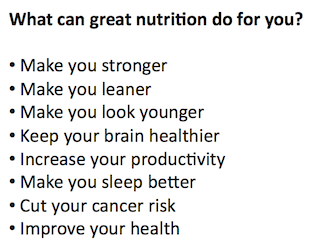Good nutrition is the foundation for a healthy lifestyle. It is essential to maintaining optimal physical and mental performance, to defending against infectious and chronic diseases, and to living a long and healthy life.
It can help protect against chronic illnesses such as heart disease, diabetes, and obesity. It can also reduce the risk of cancer, stroke, and heart attack. Additionally, it can help make you leaner and stronger, making you look younger. Unfortunately, we as a culture are not generally well informed with regard to proper diet. Worse yet, many popular diet systems and “fad diets” counter good nutritional practices.
Read on on to learn about how to eat healthy. Also, check out The Guiding Principles of Nutrition: How to Eat Healthy Infographic, which visually provides the core principles of good nutrition. Learn how to consume a well-balanced diet with the recommended proportions of proteins, fats, and carbohydrates and how to choose “healthy” proteins, fats, and carbohydrates. Also, learn which specific foods are healthy and which foods are unhealthy. (See Core Nutrition Articles for EMG’s full collection of nutrition articles.)
What Is Good Nutrition?
Good nutrition is not a fad diet or a one-size-fits-all program. It is a set of principles (not rules) that provide individuals with the understanding of how to consume the appropriate balance of nutrients to maintain optimal health and performance. Because it is a set of principles, this how to eat healthy guide can be applied across a wide variety of life situations.
Just like with any activity, optimizing one’s diet requires time, understanding, and effort. Fortunately, EMG provides the fundamental principles on how to eat healthy in a concise, comprehensive, and easily understood format.
How to Eat Healthy: The Guiding Principles
Good nutrition can be simple: learn the basic principles and practice them consistently. Just like anything in life, optimizing nutrition requires knowledge and discipline. Below are guiding principles that can be applied across a wide variety of individual needs and preferences.
- 1. Consume a well-balanced diet consisting of recommended amounts of macronutrients (protein, carbohydrates, and fats) – Shown below is the typical American diet compared to a healthier, more well balanced diet. The typical American diet consists of far too much sugar and unhealthy fats, like saturated fat. Sugar should be eliminated entirely and saturated fat should be limited.
The well balanced diet consists of a more sensible combination of necessary macronutrients. In general, a well-balanced diet consists of 15-25% protein, 50-65% carbohydrates, and 20-25% fats. Each macronutrient serves essential roles within the body, so a well balanced diet must include all three (protein, carbohydrates, and fats). (See Proteins, Carbohydrates, and Fats).
- 2. Choose “healthy” proteins, fats, and carbohydrates – Within each macronutrient class, there are healthy options and unhealthy options.
- Proteins – Healthy proteins include lean meats (particularly organic, grass-fed meats), eggs, and dairy (all in moderation) as well as whole-grains, beans, nuts/seeds, vegetables, and soy products. (For more comprehensive information, see What is Protein and High Protein Foods List).
- Carbohydrates – Carbohydrates are broken down into two categories: Simple Carbohydrates and Complex Carbohydrates. Simple carbohydrates are simple sugars, like glucose and fructose. They are digested and absorbed into the bloodstream quickly, giving the body a quick energy high. Simple carbs can produce a corresponding energy low, potentially leading to hunger cravings and excessive eating.
Complex carbs are long strands made up of many simple carbs. In order to be digested, they must be broken down over time. Therefore, complex carbs take longer to absorb into the bloodstream providing a longer-lasting energy supply resulting in reduced hunger cravings.
A vast majority of carbohydrate consumption should come in the form of complex carbohydrates (whole-grains, vegetables). Avoid simple carbohydrate sources (sugars) with the only exception being fresh fruits.
- Fats – Fats are broken down into two broad categories: Saturated Fat and Unsaturated Fat. Healthier fats include unsaturated fat (fats from plant sources): monounsaturated fat and Polyunsaturated Fat. Saturated fats (fats from animal sources) are less healthy. High saturated fat consumption increases one’s risks of heart disease, heart attack, and stroke. Most fat consumption should be unsaturated fat not saturated fat. Limit saturated fat consumption and completely avoid Trans Fat consumption.
- 3. Optimize your nutritional intake by choose whole-food options over processed alternatives – Processed foods are certainly more convenient in a fast-paced society. However, refined foods are stripped of essential nutrients like vitamins and minerals. Food manufacturers fortify processed foods with vitamins, minerals, and fiber, but these added nutrients do not have the same health-preserving effects as whole-foods. Whole-foods also possess more of these essential nutrients, and the nutrients are more easily utilized within the body (Healthiest Foods List).
- 4. Start the day with a healthy breakfast and continue to eat regularly in moderation – Eat a basic breakfast consisting of complex carbohydrates, proteins, and healthy fats. Continue to feed yourself every three to four hours with moderately sized meals consisting of complex carbohydrates, proteins, and healthy fats.
How to Eat Healthy Infographic
Share this How to Eat Healthy Infographic on Your Site
Reference: https://www.yourfitnesstoday.com/guiding-principles-nutrition-infographic/
Image: https://www.yourfitnesstoday.com/assets/The-Guiding-Principles-of-Nutrition-How-to-Eat-Healthy.png
External Resources: HelpGuide.org: How to Eat Healthy
Updated: April 17, 2015







